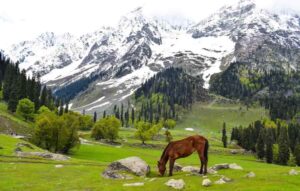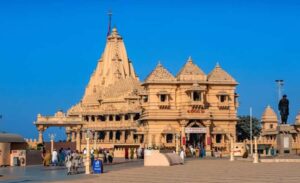History of Nageshwar jyotirlinga Temple
Nageshwar Jyotirlinga: According to the Shiv Puran, remembering the 12 Jyotirlingas during the month of Sawan alone relieves a person of all troubles. In the twelve Jyotirlingas, the tenth place is occupied by Nageshwar Jyotirlinga. In the Rudra Samhita, Shiva is described as ‘Darukavan Nagesham.’ It is believed that visiting this place puts an end to all sins. Let’s learn about the history and significance of Nageshwar Jyotirlinga.

Baba Nageshwar, Delivering Liberation from Snake Doshas
Nageshwar Jyotirlinga is located 17 kilometers outside the Dwarka Dham in Gujarat. The meaning of Nageshwar is the deity of snakes. Those who have a snake dosha in their horoscope should offer snake idols made of metals here, as it is believed to provide relief from snake doshas.
The Story of Nageshwar Jyotirlinga (Nageshwar Jyotirlinga Katha)
According to the Puranic story, there was a demon maiden named Daruka who was not allowed to go to the Daruka forest. She performed rigorous penance and pleased Goddess Parvati. When Goddess Parvati asked Daruka for a boon, the demoness requested various divine medicines for the welfare of demons in the forest. She also sought the boon of allowing demons to enter the forest for righteous deeds.
Daruka Turned a Shiva Devotee Into a Captive
Goddess Parvati was pleased with the thoughts of the demoness and granted her the boon to enter the Daruka forest. However, as soon as she received the boon, Daruka and other demons took control of the forest from the deities. In the forest, there was a Shiva devotee named Supriya, whom Daruka captured and made her a prisoner. Subsequently, Supriya performed penance for Shiva and sought the boon of the destruction of demons.
Establishment of Nageshwar Jyotirlinga in This Way
Supriya, by meditating on Shiva, prayed for her own protection and the destruction of demons. To protect his supreme devotee, Lord Shiva manifested as a divine light from a bil (a type of tree). Lord Shiva annihilated the demons. Supriya worshipped the Jyotirlinga in the prescribed manner and requested Shiva to stay at that place. Lord Shiva, honoring the request of his devotee, decided to stay there. In this way, the form of Lord Shiva as the Jyotirlinga came to be known as ‘Nageshwar.’
Also Read








